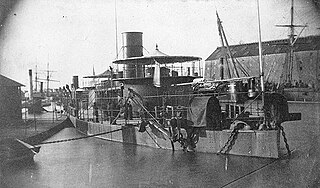
The Philadelphia Naval Shipyard was the first United States Navy shipyard and was historically important for nearly two centuries.

USS Williams (DD-108) was a Wickes-class destroyer in the United States Navy entering service in 1919, and was the second ship to bear the name. Following a brief stint in active service, the ship was laid up for 17 years before being reactivated during World War II. Williams transferred to the Royal Canadian Navy during World War II as part of Lend-Lease and was renamed HMCS St. Clair (I65), surviving the war and being scrapped in 1946.

The third USS Bainbridge (DD-246) was a united States Navy Clemson-class destroyer in commission from 1921 to 1930, from 1932 to 1937, and from 1939 to 1945. She served during World War II. She was named for Commodore William Bainbridge, who served in the War of 1812 and the First and Second Barbary Wars.

USS Osborne (DD-295) was a Clemson-class destroyer in the United States Navy following World War I. She was named for Weedon Osborne.

The first USS Talbot was a torpedo boat in the United States Navy.

United States Naval Districts is a system created by the United States Navy to organize military facilities, numbered sequentially by geographic region, for the operational and administrative control of naval bases and shore commands in the United States and around the world. Established in 1903, naval districts became the foundational system for organizing U.S. naval forces ashore during the 20th century. The term "Naval" forces includes United States Marine Corps and current United States Coast Guard units.

The Miantonomoh class consisted of four monitors built for the Union Navy during the U.S. Civil War, but only one ship was completed early enough to participate in the war. They were broken up in 1874–1875.

USS Monmouth County (LST-1032) was an LST-542-class tank landing ship built for the United States Navy during World War II. Named after Monmouth County, New Jersey, she was the only U.S. Naval vessel to bear the name.

Asbury Park was a high-speed coastal steamer built in Philadelphia, and intended to transport well-to-do persons from New York to summer homes on the New Jersey shore. This vessel was sold to West Coast interests in 1918, and later converted to an automobile ferry, serving on various routes San Francisco Bay, Puget Sound and British Columbia. This vessel was known by a number of other names, including City of Sacramento, Kahloke, Langdale Queen, and Lady Grace.
USS Yacal (YFB-688) was a small ferry that served in the United States Navy from 1932 to 1942. She was named after the yacal tree, which has hard wood, which was also the primary construction material used to build her.

The second USS Wando, later YT-17, later YT-123, later YTB-123, was a United States Navy tug in commission from 1917 to 1946.
Lillian Anne (YFB-41) was a United States Navy ferry in service from 1942 to 1943.
The fourth USS Despatch, originally USS Steam Cutter No. 423, later USS Hustle (YFB-6), was a ferry launch that served in the United States Navy from 1902 to 1921.

USS Charles (ID-1298) was a troop transport that served in the United States Navy from 1918 to 1920 and was briefly in commission as USS Harvard in 1918 and 1920. She was better known in her role as passenger liner SS Harvard, one of the premier West Coast steamships operated by the Los Angeles Steamship Company.

USS Dart (YFB-308) was a United States Navy ferry launch in service from 1900 to 1930, when she was transferred to the United States Lighthouse Service, and renamed the Locust, she was later transferred to the United States Coast Guard, until she was decommissioned in 1954.

The first USS Moosehead (ID-2047), later the fourth USS Porpoise (YFB-2047), was a steamer that served in the United States Navy from 1918 to 1930.
USS Pilgrim II (YFB-30) was a United States Navy motor launch employed as a river patrol boat during her naval service from 1942 to 1947.

The first USS Patchogue (ID-1227), later YFB-1227, was a United States Navy ferry in service from 1917 to 1922.

San Felipe (YFB-12) (ex-Engineer) was a United States Army steel tugboat that later served as a ferryboat in the U.S. Navy and as an Imperial Japanese Army transport during World War II.

USS Pima County (LST-1081) was an LST-542-class tank landing ship of the United States Navy. Built by the American Bridge Company in Ambridge, Pennsylvania from 13 November 1944 she was commissioned into the navy on 30 January 1945. LST-1081 saw service as a logistics vessel in the latter stages of the Pacific War but was placed into reserve and decommissioned after the war. She was recommissioned in 1950 after the outbreak of the Korean War and served with the Atlantic Fleet, including a deployment in the Mediterranean Sea during which she was renamed USS Pima County. She returned to the reserve in 1956 and was decommissioned on 12 December of that year.















